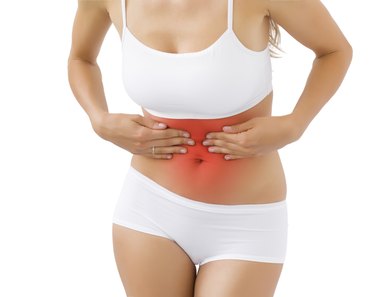
Physicians divide the abdomen into quadrants to evaluate symptoms such as pain. While you may be unable to pinpoint exactly which internal organs are causing you pain, you can usually distinguish among the quadrants. Pain in your upper right abdominal quadrant may originate in one of the organs that reside there, such as the liver, pancreas or gallbladder. Eating excess fats and sugars may exacerbate pain in these organs because they play a role in digestion. See your physician if you are experiencing right upper quadrant pain to find out the cause and your options for treatment.
Liver
Video of the Day
Your liver is a large organ located in your abdomen, mainly on the right. It serves many crucial functions, which include helping your blood clot, metabolizing medications and aiding digestion. Your liver secretes bile to help you digest fats. If you have a problem with your liver, eating a lot of fat may trigger upper right quadrant pain. Research reported in "U.S. News & World Report" says that a diet high in sugars can also contribute to nonalcoholic fatty liver disease, or NAFLD. According to MayoClinic.com, NAFLD can cause upper right quadrant pain and, in severe cases, sometimes lead to more serious conditions such as cirrhosis of the liver. Other liver conditions that can cause upper right quadrant pain include hepatitis, cirrhosis, bile duct blockage or liver cancer.
Video of the Day
Gallbladder
Your gallbladder is a sac-like organ located in the upper right quadrant of your abdomen. It stores and concentrates the bile your liver makes. When your stomach becomes full, your duodenum releases a hormone called cholecystokinin, or CCK. CCK causes your pancreas to release digestive enzymes and your gallbladder to contract and release bile. The bile your gallbladder releases is very important for the digestion of fats, so a high-fat meal will cause your liver to excrete more bile and your gallbladder to contract more. If you have gallbladder disease such as cholecystitis, which is an inflammation of the gallbladder, gallstones or duct problems, you may suffer upper right quadrant pain after eating, especially high-fat food.
Pancreas
Your pancreas is located in your upper abdomen behind your stomach. It is mostly in the center of your abdomen, but it can cause upper right quadrant pain when it becomes inflamed. In addition to releasing hormones such as insulin and glucagon into your bloodstream, your pancreas plays a key role in helping your body digest sugars, fats and proteins. Your pancreas releases digestive enzymes just after you eat, so problems with your pancreas can cause pain after you eat, especially if your meal is high in fat, sugar or protein. Conditions of the pancreas include pancreatitis, problems with the pancreatic duct, pancreatic cysts and pancreatic cancer.
Medical Tests
If you are experiencing upper right quadrant pain, your doctor will ask you about your symptoms. If she suspects a problem with your liver, she will probably order a blood test to check for elevated levels of enzymes that would indicate that your liver is in distress. She may also order an ultrasound, computed axial tomography, or CT scan, a magnetic resonance imaging, or MRI scan or a liver biopsy. If she suspects a gallbladder problem, she will probably order a gallbladder ultrasound or an ejection fraction test, in which she injects CCK and uses an x-ray scanner to see how often your gallbladder contracts. If she suspects pancreas problems, she may order blood tests or stool samples, since conditions such as pancreatitis can cause fatty stools.
- Colorado State University Biomedical Hypertexts; Secretion of Bile and the Role of Bile Acids in Digestion; R. Bowen
- Colorado State University Biomedical Hypertexts; The Liver: Introduction and Index; R. Bowen
- Colorado State University Biomedical Hypertexts; Cholecystokinin; R. Bowen
- U.S. News & World Report; Nonalcoholic Fatty Liver Disease: 5 Tips for Treatment, Prevention; Payne, January W.; April 2009
- InnerBody.com; Digestive System
Is this an emergency? If you are experiencing serious medical symptoms, please see the National Library of Medicine’s list of signs you need emergency medical attention or call 911.